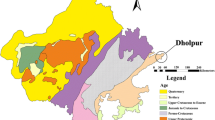Abstract
Shale is a very important sedimentary rock that is used as building construction material and found predominantly underground. Shales have been found to contain both oil and gas, which can be extracted only when it is fractured. In this paper, temperature dependent thermal properties of Jhiri shale are presented over a temperature range from air-dried to 900 °C. Porosity, density, and compressional wave velocity measurement have been done as per ISRM standard. Furthermore, internal microstructure is studied using scanning electron microscopy (SEM). In this study, thermal conductivity is predicted using P-wave velocity and porosity of Jhiri shale. The effect of temperature on microstructure, porosity, and mineralogical composition and dependency of thermal conductivity on porosity is discussed. It was found that as temperature increases, porosity of Jhiri shale also increases because of thermal cracking, which acts as a barrier of heat flow, reducing thermal conductivity. Uncertainties of measured quantities are calculated and the total combined expanded uncertainty for thermal conductivity value at 95 % confidence level have been found to be less than 6 %.










Similar content being viewed by others
References
Abdulagatov IM, Emirov S, Abdulagatova ZZ, Askerov SY (2006) Effect of pressure and temperature on the thermal conductivity of rocks. J Chem Eng Data 51:22–33
Abdulagatova Z, Abdulagatov IM, Emirov VN (2009) Effect of temperature and pressure on the thermal conductivity of sandstone. Int J Rock Mech Min Sci 46:1055–1071
Afifi A, May S, Clark VA (2012) Practical multivariate analysis, 5th edn. CRC Press, USA
Alishaev MG, Abdulagatov IM, Abdulagatova ZZ (2012) Effective thermal conductivity of fluid-saturated rocks experiment and modeling. Eng Geol 135–136:24–39
Barry-Macaulay D, Bouazza A, Singh RM, Wang B, Ranjith PG (2013) Thermal conductivity of soils and rocks from the Melbourne (Australia) region. Eng Geol 164:131–138
Bergman TI, Lavine AS, Incropera FP, Dewitt DP (2002) Fundamentals of heat and mass transfer, 7th edn. Wiley, USA
Chakraborty PP (2006) Outcrop signatures of relative sea level fall on a siliciclastic shelf: examples from the Rewa Group of Proterozoic Vindhyan basin. J Earth Syst Sci 115(1):23–36
Clauser C (1988) Opacity the concept of radiative thermal conductivity. In: Haenel R, Rybach L, Stegena L (eds) Handbook of terrestrial heat flow density determination. Kluwer Academic Publishers, Dordrecht, pp 143–165
Clauser C, Huenges E (1995) Thermal conductivity of rocks and minerals. In: Ahrens TJ (ed) Rock physics and phase relations: a handbook of physical constants. American Geophysical Union, Washington DC, pp 105–126
Dao L-Q, Delage P, Tang A-M, Cui Y-J, Pereira J-M, Li X-L, Sillen X (2014) Anisotropic thermal conductivity of natural boom clay. Appl Clay Sci 101:282–287
Duchkov AD, Sokolova LS, Rodyakin SV, Chernysh PS (2014) Thermal conductivity of the sedimentary-cover rocks of the West Siberian plate in relation to their humidity and porosity. Russ Geol Geophys 55:784–792
Garitte B, Gens A, Vaunat J, Armand G (2014) Thermal conductivity of argillaceous rocks: determination methodology using in situ heating tests. Rock Mech Rock Eng 47:111–129. doi:10.1007/s00603-012-0335-x
Gegenhuber N, Schoen J (2012) New approaches for the relationship between compressional wave velocity and thermal conductivity. J Appl Geophys 76:50–55
Hasan A (1999) Optimizing insulation thickness for buildings using life cycle cost. Appl Energy Amst Elsevier 63:115–124
Nagaraju P, Roy S (2014) Effect of water saturation on rock thermal conductivity measurements. Tectonophysics 626:137–143
Ozkahraman HT, Selver R, Isık EC (2004) Determination of the thermal conductivity of rock from P-wave velocity. Int J Rock Mech Min Sci 41:703–708
Pasquale V, Verdoya M, Chiozzi P (2015) Measurements of rock thermal conductivity with a transient-divided- bar. Geothermics 53:183–189
Peierls RE (1955) Quantum theory of solids. Oxford University Press, Oxford
Popov YA, Pribnow DFC, Sass JH, Williams CF, Burkhardt H (1999) Characterization of rock thermal conductivity by high resolution optical scanning. Geothermics 28:253–276
Prasad BR, Rao VV (2006) Deep seismic reflection study over the Vindhyans of Rajasthan: implications for geophysical setting of the basin. J Earth Syst Sci 115(1):135–147
Ray L, Bhattacharya A, Roy S (2007) Thermal conductivity of higher Himalayan crystallines from Garhwal Himalaya India. Tectonophysics 434:71–79
Seipold U (1997) Temperature dependence of thermal transport properties of crystalline rocks—a general law. Tectonophysics 291:161–171
Singh TN, Sinha S, Singh VK (2007) Prediction of thermal conductivity of rock through physico mechanical properties. Build Environ 42:146–155
Sipio DE, Chiesa S, Destro E, Galgaro A, Giaretta A, Gola G, Manzalla A (2013) Rock thermal conductivity as key parameter for geothermal numerical models. Energy Procedia 40:87–94
Somerton WH (1992) Thermal properties and temperature related behavior of rock/fluid system. Elsevier, Amsterdam
Verma AK, Bajpai RK, Singh TN, Narayan PK, Avi D (2010) 3D instability analysis of an underground geological repository—an Indian case study. Arab J Geosci. doi:10.1007/s12517-010-0131-4
Verma AK, Saini MS, Singh TN, Avi D, Bajpai RK (2013) Effect of excavation stages on stress and pore pressure changes for an underground nuclear repository. Arab J Geosci 6(3):635–645
Vishal V, Pradhan SP, Singh TN (2011) Tensile strength of rock under elevated temperatures. Geotech Geol Eng 29(6):1127–1133
Acknowledgments
The author would like to express gratitude to the INSPIRE Faculty Award by Department of Science and Technology, GOI, India, for providing the research grant. The authors are also thankful to Prof. V. M. S. R. Murthy for allowing us to conduct P-wave and S-wave tests in the Rock Excavation Laboratory of the Indian School of Mines Dhanbad, India.
Author information
Authors and Affiliations
Corresponding author
Rights and permissions
About this article
Cite this article
Jha, M.K., Verma, A.K., Maheshwar, S. et al. Study of temperature effect on thermal conductivity of Jhiri shale from Upper Vindhyan, India. Bull Eng Geol Environ 75, 1657–1668 (2016). https://doi.org/10.1007/s10064-015-0829-3
Received:
Accepted:
Published:
Issue Date:
DOI: https://doi.org/10.1007/s10064-015-0829-3




